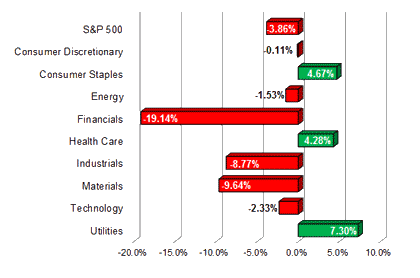
Market Commentary by Scott J. Brown, Ph.D., Chief Economist

Europe was the dominant factor for the markets, with fear (early in the week) giving way to some optimism (or at least, less pessimism) after European leaders expressed support for Greece and the euro, the BRICs offered some support (in buying European debt), and central banks announced dollar liquidity-providing operations. At this point, we’ve had more words than action. The news out of Europe is likely to vary over the next few weeks, which should have some day-to-day impact on the U.S. stock market.
The economic data were disappointing, although stock market participants did not seem to care. Retail sales were flat in August and figures for June and July were revised slightly lower. Industrial production rose modestly in August, restrained by a drop in the output of utilities (cooler weather) and supported partly by a gain in motor vehicle production – results were mixed across industries.
The Consumer Price Index rose 0.4% in August (+3.8%), boosted partly by a 1.9% increase in gasoline (which fell 0.5% before seasonal adjustment). Ex-food & energy, the CPI rose 0.2% (+2.0% y/y, at the upper end of the Fed’s comfort range) – a 2.6% annual rate in the first eight months of 2011 (vs. a +0.8% pace over the last half of 2010).
Next week, the focus will be on the Fed policy meeting. Public comments of senior Fed officials have been mixed, but the majority view appears to be that further monetary policy accommodation is warranted. It’s just a question of what the Fed will come up with. Fed officials will debate the possible costs and benefits of the available tools. It’s expected that we’ll see (most likely) a lengthening of maturities in the Fed’s portfolio or (possibly) another round of asset purchases (“QE3”).
Indices
| Last | Last Week | YTD return % | |
| DJIA | 11433.18 | 11295.81 | -1.25% |
| NASDAQ | 2607.07 | 2529.14 | -1.73% |
| S&P 500 | 1209.11 | 1185.90 | -3.86% |
| MSCI EAFE | 1425.29 | 1453.64 | -14.05% |
| Russell 2000 | 713.51 | 694.92 | -8.95% |
Consumer Money Rates
| Last | 1-year ago | |
| Prime Rate | 3.25 | 3.25 |
| Fed Funds | 0.12 | 0.22 |
| 30-year mortgage | 4.18 | 4.5 |
Currencies
| Last | 1-year ago | |
| Dollars per British Pound | 1.581 | 1.562 |
| Dollars per Euro | 1.387 | 1.300 |
| Japanese Yen per Dollar | 76.740 | 85.740 |
| Canadian Dollars per Dollar | 0.986 | 1.028 |
| Mexican Peso per Dollar | 12.944 | 12.787 |
Commodities
| Last | 1-year ago | |
| Crude Oil | 89.40 | 76.02 |
| Gold | 1780.58 | 1267.35 |
Bond Rates
| Last | 1-month ago | |
| 2-year treasury | 0.19 | 0.20 |
| 10-year treasury | 2.08 | 2.08 |
| 10-year municipal (TEY) | 3.21 | 3.37 |
Treasury Yield Curve – 9/16/2011
S&P Sector Performance (YTD) – 9/16/2011
Economic Calendar
| September 19th |
— |
Homebuilder Sentiment (September) |
| September 20th |
— |
Building Permits, Housing Starts (August) IMF World Economic Outlook FOMC Meeting Begins |
| September 21st |
— |
Existing Home Sales (August) FOMC Policy Meeting (no press briefing) |
| September 22nd |
— |
Jobless Claims (week ending September 17th) Leading Economic Indicators (August) |
| September 26th |
— |
Durable Goods Orders (August) |
| September 27th |
— |
Consumer Confidence (September) |
| October 7th |
— |
Employment Report (September) |
| October 10th |
— |
Columbus Day (bond market closed) |
| November 2nd |
— |
FOMC Policy Decision (+Bernanke press briefing) |
Important Disclosures
Past performance is not a guarantee of future results. There are special risks involved with global investing related to market and currency fluctuations, economic and political instability, and different financial accounting standards. The above material has been obtained from sources considered reliable, but we do not guarantee that it is accurate or complete. There is no assurance that any trends mentioned will continue in the future. While interest on municipal bonds is generally exempt from federal income tax, it may be subject to the federal alternative minimum tax, state or local taxes. In addition, certain municipal bonds (such as Build America Bonds) are issued without a federal tax exemption, which subjects the related interest income to federal income tax. Investing involves risk and investors may incur a profit or a loss.
US government bonds and treasury bills are guaranteed by the US government and, if held to maturity, offer a fixed rate of return and guaranteed principal value. US government bonds are issued and guaranteed as to the timely payment of principal and interest by the federal government. Treasury bills are certificates reflecting short-term (less than one year) obligations of the US government.
Commodities trading is generally considered speculative because of the significant potential for investment loss. Markets for commodities are likely to be volatile and there may be sharp price fluctuations even during periods when prices overall are rising. Specific sector investing can be subject to different and greater risks than more diversified investments.
Tax Equiv Muni yields (TEY) assume a 35% tax rate on triple-A rated, tax-exempt insured revenue bonds.
![]() Material prepared by Raymond James for use by its financial advisors.
Material prepared by Raymond James for use by its financial advisors.
The information contained herein has been obtained from sources considered reliable, but we do not guarantee that the foregoing material is accurate or complete. Data source: Bloomberg, as of close of business September 15th, 2011.
©2011 Raymond James Financial Services, Inc. member FINRA / SIPC.




